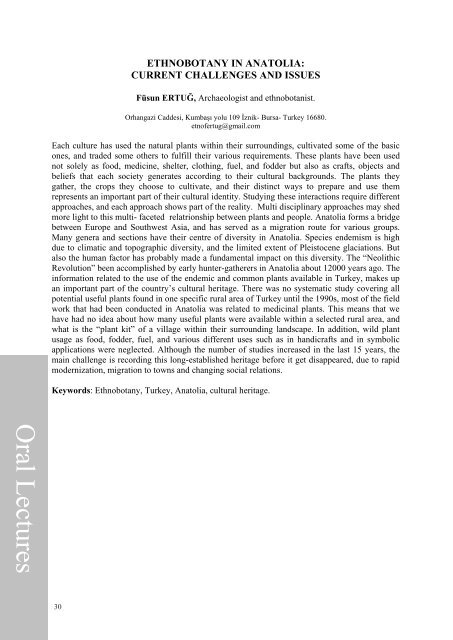Adil GÜNER, Vehbi ESER - optima
Adil GÜNER, Vehbi ESER - optima
Adil GÜNER, Vehbi ESER - optima
Create successful ePaper yourself
Turn your PDF publications into a flip-book with our unique Google optimized e-Paper software.
Oral Lectures<br />
30<br />
ETHNOBOTANY IN ANATOLIA:<br />
CURRENT CHALLENGES AND ISSUES<br />
Füsun ERTU�, Archaeologist and ethnobotanist.<br />
Orhangazi Caddesi, Kumba�� yolu 109 �znik- Bursa- Turkey 16680.<br />
etnofertug@gmail.com<br />
Each culture has used the natural plants within their surroundings, cultivated some of the basic<br />
ones, and traded some others to fulfill their various requirements. These plants have been used<br />
not solely as food, medicine, shelter, clothing, fuel, and fodder but also as crafts, objects and<br />
beliefs that each society generates according to their cultural backgrounds. The plants they<br />
gather, the crops they choose to cultivate, and their distinct ways to prepare and use them<br />
represents an important part of their cultural identity. Studying these interactions require different<br />
approaches, and each approach shows part of the reality. Multi disciplinary approaches may shed<br />
more light to this multi- faceted relatrionship between plants and people. Anatolia forms a bridge<br />
between Europe and Southwest Asia, and has served as a migration route for various groups.<br />
Many genera and sections have their centre of diversity in Anatolia. Species endemism is high<br />
due to climatic and topographic diversity, and the limited extent of Pleistocene glaciations. But<br />
also the human factor has probably made a fundamental impact on this diversity. The “Neolithic<br />
Revolution” been accomplished by early hunter-gatherers in Anatolia about 12000 years ago. The<br />
information related to the use of the endemic and common plants available in Turkey, makes up<br />
an important part of the country’s cultural heritage. There was no systematic study covering all<br />
potential useful plants found in one specific rural area of Turkey until the 1990s, most of the field<br />
work that had been conducted in Anatolia was related to medicinal plants. This means that we<br />
have had no idea about how many useful plants were available within a selected rural area, and<br />
what is the “plant kit” of a village within their surrounding landscape. In addition, wild plant<br />
usage as food, fodder, fuel, and various different uses such as in handicrafts and in symbolic<br />
applications were neglected. Although the number of studies increased in the last 15 years, the<br />
main challenge is recording this long-established heritage before it get disappeared, due to rapid<br />
modernization, migration to towns and changing social relations.<br />
Keywords: Ethnobotany, Turkey, Anatolia, cultural heritage.<br />
18






